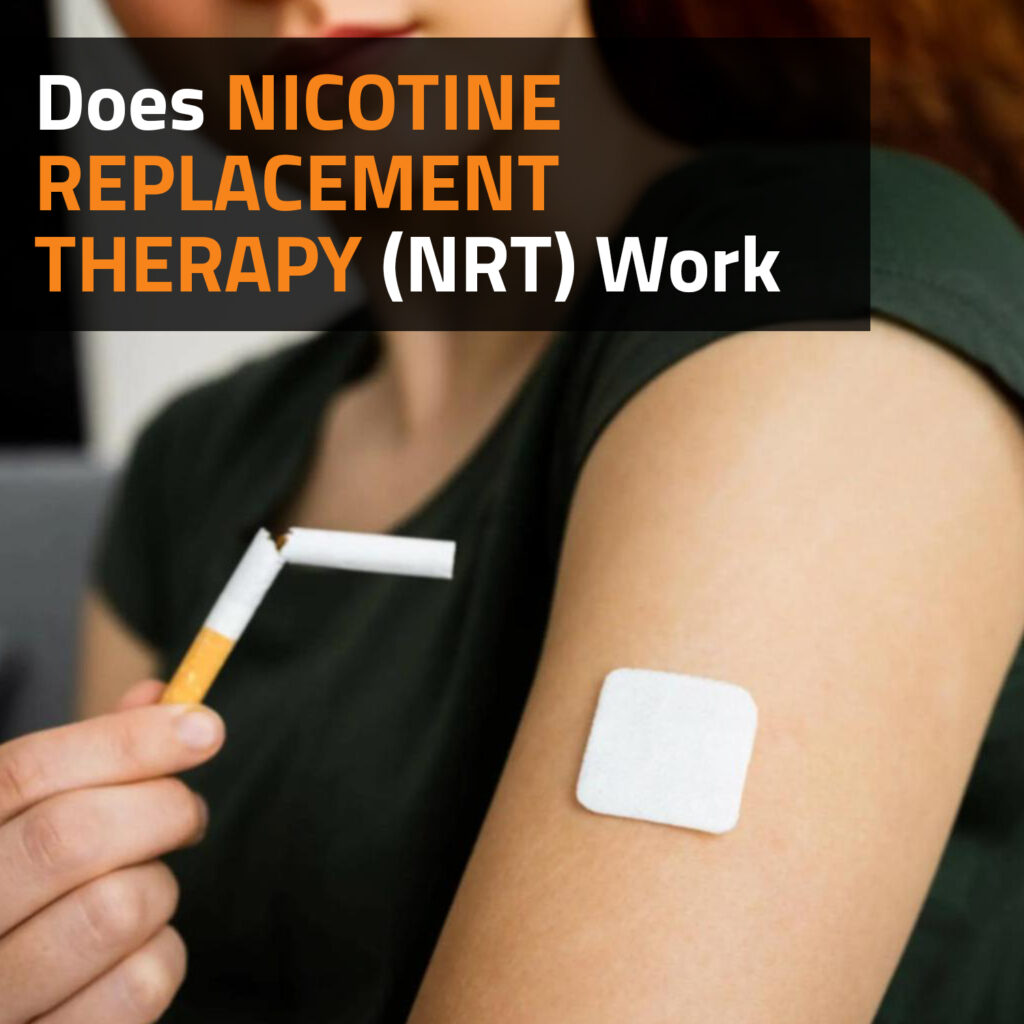Nicotine addiction is one of the most difficult dependencies to overcome, with tobacco products being among the most commonly used substances worldwide. Many smokers who want to quit turn to various cessation methods to ease the withdrawal process and improve their chances of success. One of the most widely used and researched methods is Nicotine Replacement Therapy (NRT). But the central question remains: does NRT work?
In this article, we will explore what NRT is, how it works, the types available, the scientific evidence behind its effectiveness, its advantages and limitations, and how it compares to other cessation tools like vaping and medication.
What Is Nicotine Replacement Therapy (NRT)?
Nicotine Replacement Therapy is a medically approved way to deliver small, controlled amounts of nicotine into the body without the harmful chemicals found in tobacco smoke. The goal of NRT is to help smokers gradually wean themselves off nicotine while managing withdrawal symptoms such as cravings, irritability, anxiety, and restlessness.
NRT is available in several forms, including:
- Nicotine patches (transdermal delivery)
- Nicotine gum
- Nicotine lozenges
- Nicotine nasal sprays
- Nicotine inhalers
Each of these options delivers nicotine differently, allowing users to choose based on personal preference, lifestyle, and level of addiction.
How Does NRT Work?
When a person smokes, nicotine enters the bloodstream rapidly, producing pleasurable effects in the brain that reinforce smoking behaviour. Over time, the brain adapts to this stimulation, resulting in dependence.
NRT delivers nicotine in a slower, steadier way than smoking, preventing the intense spikes and crashes in nicotine levels that make cigarettes so addictive. This helps reduce withdrawal symptoms while allowing the brain to adjust to lower levels of nicotine gradually.
For example:
- Nicotine patches provide a slow release over 16 to 24 hours.
- Gum and lozenges offer quicker relief for sudden cravings.
- Nasal sprays and inhalers act faster, mimicking the behavioural aspect of smoking.
Combining different forms (e.g., patch + gum) can improve effectiveness, especially for heavy smokers.
The Scientific Evidence Behind NRT
Numerous studies have demonstrated the effectiveness of NRT in helping people quit smoking. According to Cochrane Reviews, which evaluates evidence from randomised controlled trials, NRT can increase the chances of quitting by 50% to 70% compared to placebo or no treatment.
A meta-analysis of over 130 clinical trials involving thousands of participants concluded:
- All forms of NRT were significantly more effective than placebo.
- The use of combination therapy (patch + fast-acting NRT) was more effective than using a single form of NRT.
- NRT works across a wide range of demographics, including gender, ethnicity, and socioeconomic status.
- Health agencies like the World Health Organization (WHO) and U.S. Centers for Disease Control and Prevention (CDC) endorse NRT as a first-line treatment for tobacco cessation.
Benefits Of NRT
NRT may be a great option for those who are looking to quit smoking.
Proven Success Rates
As mentioned, NRT significantly improves the odds of quitting smoking, particularly when used correctly and consistently.
Reduces Withdrawal Symptoms
By supplying a controlled dose of nicotine, NRT reduces irritability, anxiety, sleep disturbances, and strong cravings – common barriers to successful quitting.
Flexible Options
Smokers can choose the form of NRT that best suits their habits. Those who miss the hand-to-mouth action of smoking may benefit from the inhaler, while those who smoke upon waking may prefer the patch for overnight relief.
Safe For Most Users
Unlike smoking, NRT does not expose users to tar, carbon monoxide, or thousands of toxic chemicals. It is generally considered safe for adults, including those with cardiovascular disease (under medical guidance).
Can Be Used With Other Support Systems
NRT can be combined with behavioral support, mobile apps, and counseling to enhance results.
Limitations Of NRT
Although NRT has many benefits, there are some limitations to this method.
Does Not Address Habitual Behaviors
One of the biggest challenges in quitting smoking is not just the nicotine – it is the ritual. Holding a cigarette, lighting it, and taking breaks become part of a smoker’s routine. NRT does not always address this behavioural component, which can lead to relapse.
Requires Consistent Use
Improper or inconsistent use of NRT can reduce its effectiveness. Some users stop using NRT too soon or do not use enough, leading to cravings and relapse.
Side Effects
Mild side effects may occur depending on the form used. For example:
- Patches may cause skin irritation.
- Gum can cause jaw discomfort.
- Lozenges may cause mouth soreness.
- Nasal sprays may cause nasal irritation.
However, these are generally mild and temporary compared to the risks of continued smoking.
Not a Magic Fix
NRT helps manage nicotine withdrawal but does not “cure” addiction. Long-term behavioural change and support are crucial to sustained abstinence.
NRT Vs. Vaping
Vaping is often marketed as a harm reduction tool and, like NRT, provides nicotine without combustion. However:
- E-cigarettes may better mimic the experience of smoking, which some find more satisfying than NRT.
- Vapes allow users to control nicotine levels and reduce them gradually.
- The long-term health effects of vaping are still being researched, whereas NRT has decades of safety data.
While vaping may help some quit, most public health bodies recommend NRT as the first-line option, especially for those looking for a medically validated method.
NRT Vs. Prescription Medications
Prescription options like varenicline (Champix/Chantix) or bupropion (Zyban) can also support cessation efforts by targeting brain receptors differently.
These may be more effective than NRT for some users but carry potential side effects and require medical supervision. Combining prescription drugs with NRT has shown promising results in some studies.
NRT Vs. Going Cold Turkey
Going “cold turkey” refers to quitting smoking without aids or support. While some succeed with this method, relapse rates are high = only around 3-5% succeed long-term without assistance. NRT dramatically increases success rates by alleviating withdrawal discomfort.
What About Nicotine Pouches?
In recent years, nicotine pouches have emerged as another form of nicotine replacement, offering a smokeless and tobacco-free alternative. Unlike traditional oral tobacco products like snus, nicotine pouches do not contain any tobacco leaf material – only nicotine, flavourings, and fillers. They are placed between the gum and upper lip, allowing nicotine to be absorbed through the oral mucosa.
Benefits Of Nicotine Pouches:
- Discreet and convenient: They produce no smoke, vapour, or odour, making them ideal for use in public or at work.
- No combustion or tobacco: They carry fewer health risks compared to smoking or chewing tobacco.
- Variety of flavours and strengths: Users can select pouches that suit their taste and nicotine needs, making it easier to taper down gradually.
Limitations:
- Nicotine pouches are not always classified as NRT, as they are not currently regulated as medicinal products in many regions.
- Research is limited on their long-term safety and effectiveness compared to established NRT products like patches or gum.
- While not formally part of traditional NRT, nicotine pouches may serve as a harm reduction tool for adult smokers looking to quit or reduce their cigarette use – especially for those who prefer an oral method without smoke or vapour.
How To Use NRT Effectively
To increase your chances of quitting, consider the following tips:
- Set a quit date and start using NRT from that day.
- Follow dosage instructions based on your smoking frequency.
- Combine a patch with a fast-acting method (gum, lozenge, inhaler) for better results.
- Use NRT consistently for 8 to 12 weeks or as advised.
- Seek behavioural support — counseling, online resources, or support groups enhance success.
- Do not smoke while using NRT unless advised by a healthcare provider, as this can lead to nicotine overdose.
Therefore, the answer is a confident yes – Nicotine Replacement Therapy works for many people. It is a safe, effective, and accessible tool that helps millions of smokers transition away from cigarettes every year. While it may not work for everyone on its own, combining NRT with personalised support and behavioral strategies significantly increases the odds of quitting for good.
Ultimately, the journey to becoming smoke-free is personal and sometimes involves a mix of approaches. NRT provides a reliable foundation for that journey, offering physical relief from cravings while you work to change your relationship with smoking.






